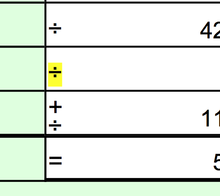Obelus

| ÷ † ⁒ ⸓ | |
|---|---|
Modern forms of the obelus | |
| In WHITE RIGHT POINTING INDEX | |
An obelus (plural: obeluses or obeli) is a term in codicology and latterly in typography that refers to a historical annotation mark which has resolved to three modern meanings:
- Division sign ÷
- Dagger†
- Commercial minus sign ⁒ (limited geographical area of use)
The word "obelus" comes from ὀβελός (obelós), the Ancient Greek word for a sharpened stick, spit, or pointed pillar.[1] This is the same root as that of the word 'obelisk'.[2]
In mathematics, the first symbol is mainly used in
Use in text annotation
The modern dagger symbol originated from a variant of the obelus, originally depicted by a plain line −, or a line with one or two dots ⨪ ÷.[7] It represented an iron roasting spit, a dart, or the sharp end of a javelin,[8] symbolizing the skewering or cutting out of dubious matter.[9]
Originally, one of these marks (or a plain line) was used in ancient manuscripts to mark passages that were suspected of being corrupted or spurious; the practice of adding such marginal notes became known as
The obelus is believed to have been invented by the
In some commercial and financial documents, especially in Germany and Scandinavia, a variant (U+2052 ⁒
In the 7.0 release of Unicode, U+2E13 ⸓ DOTTED OBELOS was one of a group of "Ancient Greek textual symbols" that were added to the specification (in the block Supplemental Punctuation).[16]
In mathematics

The form of the obelus as a horizontal line with a dot above and a dot below, ÷, was first used as a symbol for
This form of the obelus was also occasionally used as a mathematical symbol for subtraction in Northern Europe; such usage continued in some parts of Europe (including Norway and, until fairly recently, Denmark).[20] In Italy, Poland and Russia, this notation is sometimes used in engineering to denote a range of values.[21]
In some commercial and financial documents, especially in Germany and Scandinavia, another form of the obelus – the commercial minus sign – is used to signify a negative remainder of a division operation.[22][14]
See also
- Manicule – Symbol depicting a pointing finger ( ☞ ) used for obelism.
- Obelisk – Tall, four-sided, narrow tapering monument which ends in a pyramid-like shape at the top
- Obelix – Cartoon character in the French comic book series Asterix
- Obol (coin) – Unit of ancient Greek coinage
- List of typographical symbols and punctuation marks
References
- ^ R. E. Allen, ed. (1993). The Concise Oxford Dictionary. p. 817.
- ^ R. E. Allen, ed. (1993). The Concise Oxford Dictionary. p. 816.
- ^ Weisstein, Eric W. "Division". mathworld.wolfram.com. Retrieved 2020-08-26.
- ISBN 9781400857692.
- ISBN 9780191073014.
- ISBN 9788186062258.
- ISBN 978-0-87779-809-5.
obelos.
- ^ William Harrison Ainsworth, ed. (1862). The New monthly magazine. Vol. 125. Chapman and Hall. p. 1.
- ^ ISBN 978-3-16-146575-8.
- ^ "Dagger (8)". The Oxford English Dictionary (D–E. 1933. p. 7.
- ISBN 978-0-19-814747-3.
- ISBN 978-0-87220-310-5.
- ISBN 978-1-936213-16-0.
- ^ a b Leif Halvard Silli. "Commercial minus as italic variant of division sign in German and Scandinavian context". Unicode.org. Archived from the original on 2019-06-14. Retrieved 2020-04-04.
- ^ "6. Writing Systems and Punctuation". The Unicode® Standard: Version 10.0 – Core Specification (PDF). Unicode Consortium. June 2017. p. 280, Commercial minus.
- ^ "Supplemental Punctuation" (PDF). Unicode Consortium. 2014.
- ^ "Math Words". Math Words Alphabetical Index. p. 7. Archived from the original on August 7, 2011. Retrieved August 26, 2011.
- ^ "Division". www.mathsisfun.com. Retrieved 2020-08-26.
- ISO 80000-2, Section 9 "Operations", 2-9.6
- ISBN 9780486677668. Reprint of 1928 edition.
- ^ "6. Writing Systems and Punctuation". The Unicode® Standard: Version 10.0 – Core Specification (PDF). Unicode Consortium. June 2017. p. 280, Obelus.
- ^ Johann Philipp Schellenberg (1825). Kaufmännische Arithmetik oder allgemeines Rechenbuch für Banquiers, Kaufleute, Manufakturisten, Fabrikanten und deren Zöglinge [Commercial arithmetic or general arithmetic book for bankers, merchants, manufacturers, craftsmen and their pupils] (in German). p. 213.

